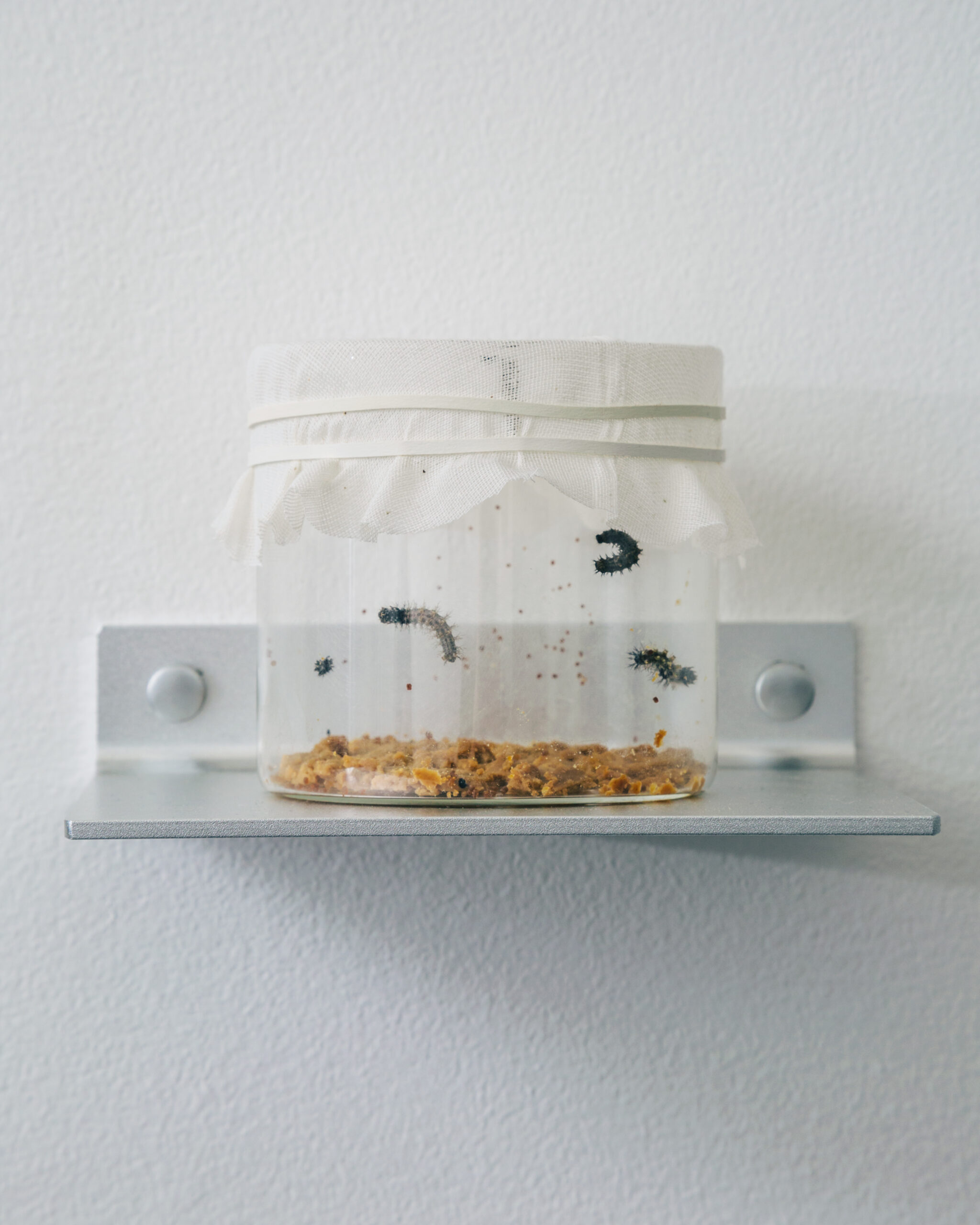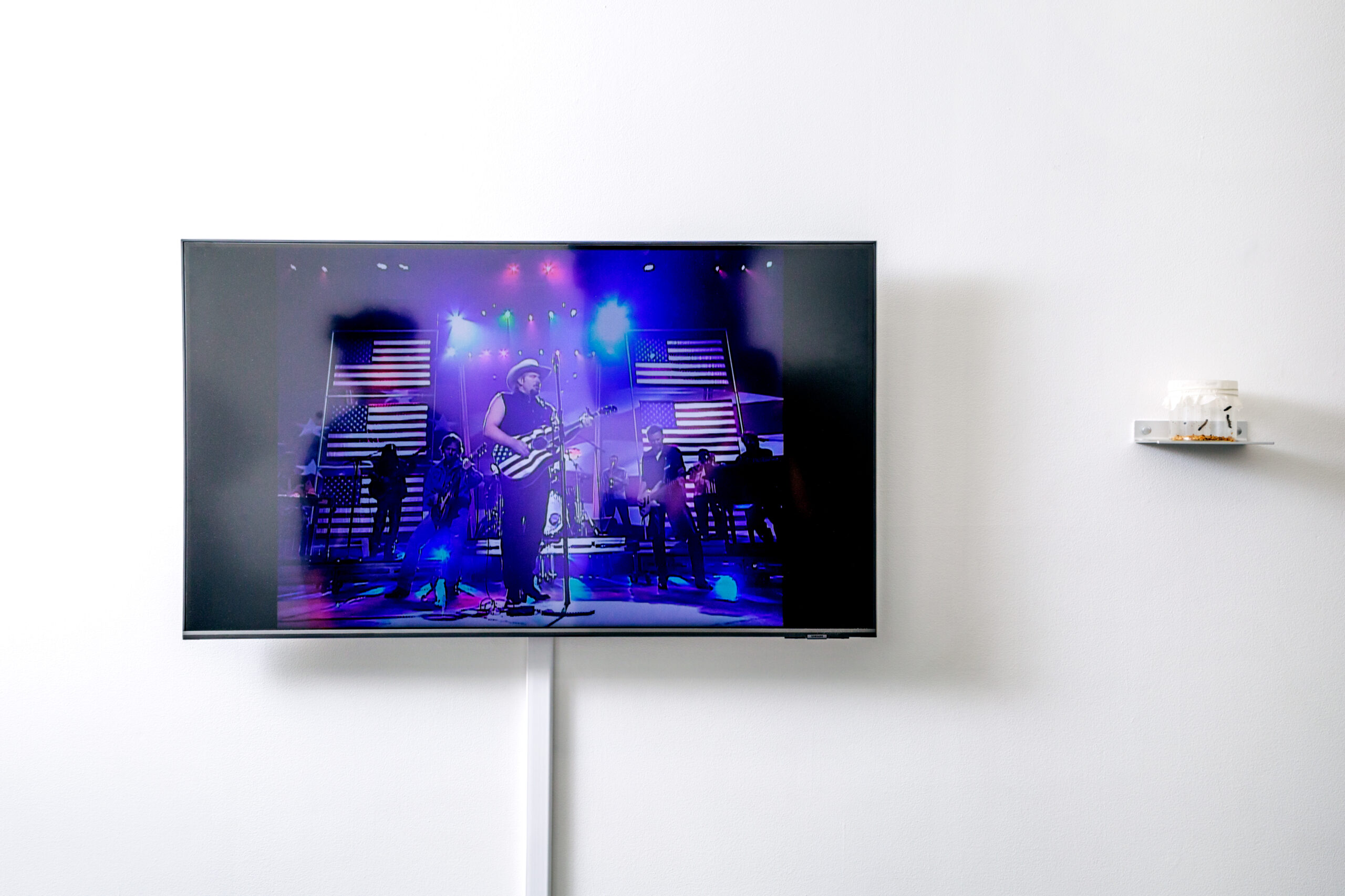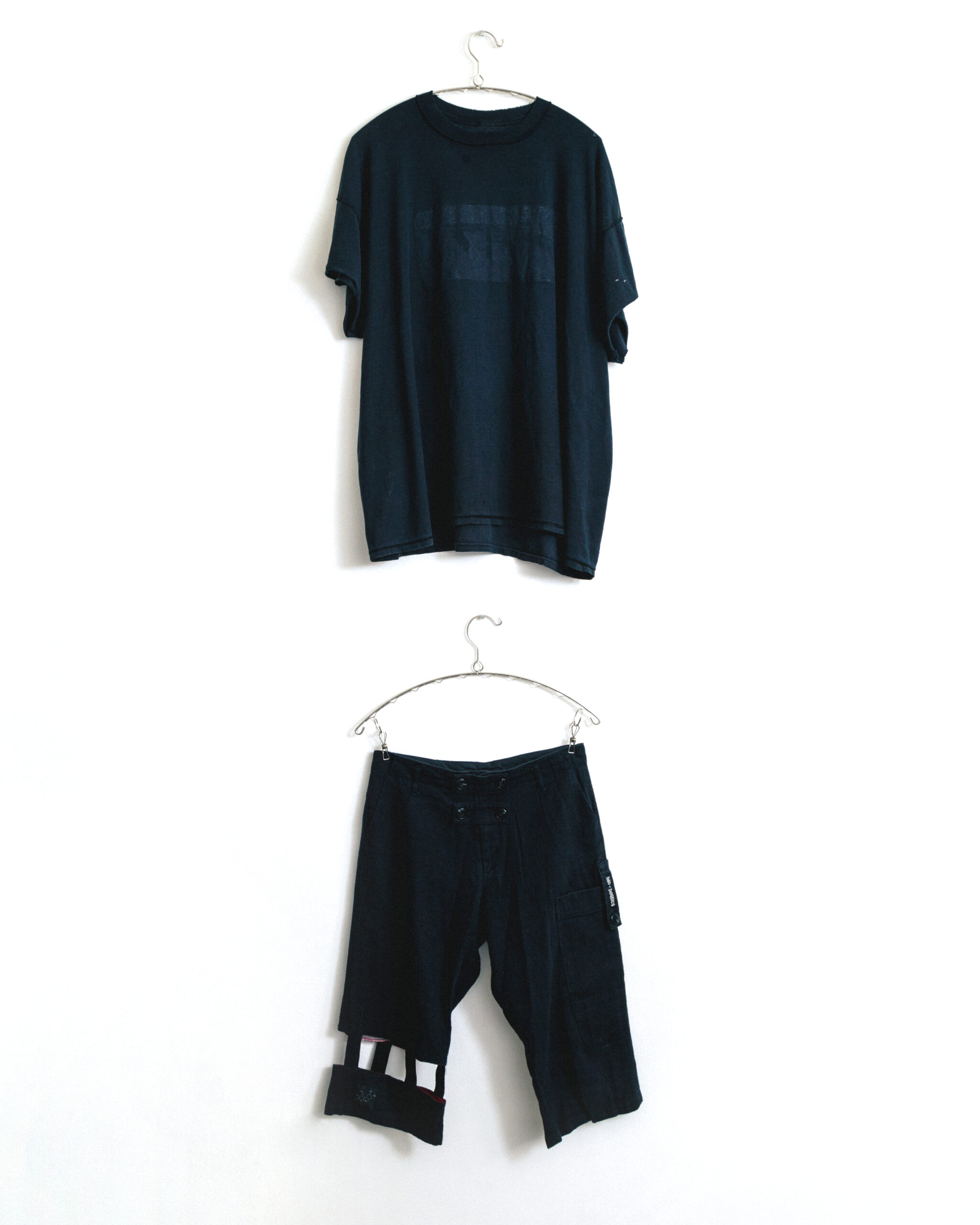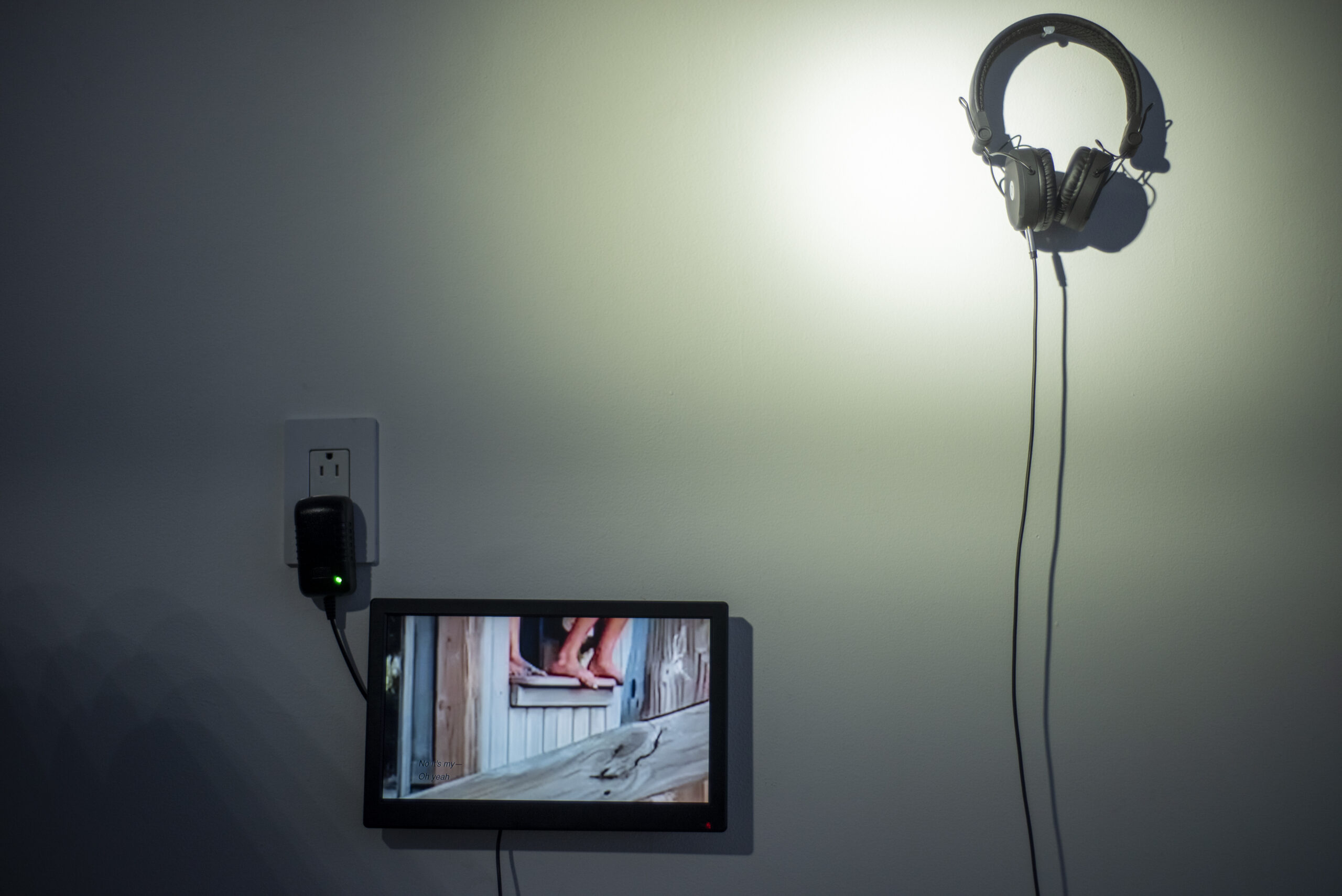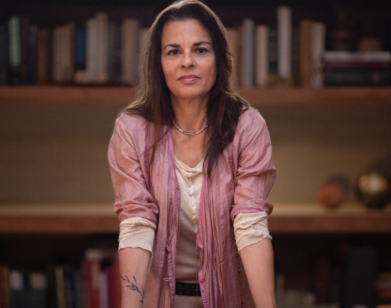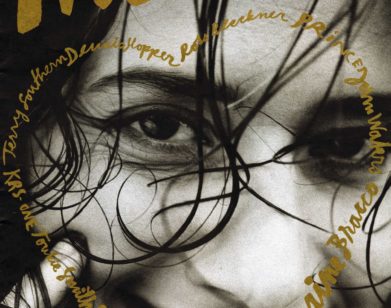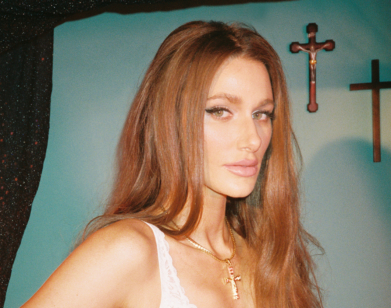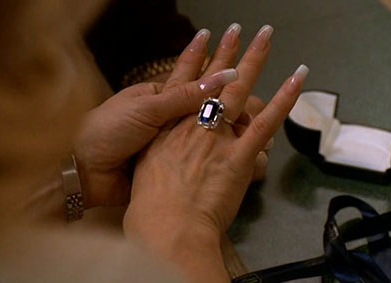OPENING
Sophia Giovannitti on Critics, Complicity, and Cowboy Theory
Sophia Giovannitti’s solo show at Blade Study is about cowboys. Less symbolically, You know I got it So come and get it, as the installation is winkingly titled, probes social engineering, info overload, imperialism, and humor. The artist and author of 2023’s Working Girl: On Selling Art and Selling Sex filled the postage-stamp downtown gallery with video and object art, mashing up Antonio Negri clips with Sopranos scenes and meme screenshots, but the show’s centerpiece was a pay-to-play lecture-performance Giovannitti delivered twice a week—the cost being $30 and some of your most identifying personal information. Habituation to data harvesting is another theme she’d considered in the making of the disruptive exhibit, she told the artist Visitor Design: “I mostly wanted to see if people would give it up,” she explained when they called each other up near the show’s closing to talk about critical book reviews, #MeToo, and the real definition of Giovannitti’s Cowboy Theory.
———
SOPHIA GIOVANNITTI: Hi Visitor Design.
VISITOR DESIGN: Hi Sophia.
GIOVANNITTI: Should we start?
DESIGN: Yeah. Where are you?
GIOVANNITTI: Circling the block of the gallery. What about you?
DESIGN: Secret.
GIOVANNITTI: Okay.
DESIGN: I wrote some questions plus preambles down.
GIOVANNITTI: Okay, you start.
DESIGN: When you first asked me to interview you, I immediately knew I had to—
GIOVANNITTI: Not to cut you off, but what a reveal, that I asked. But you are right, I did.
DESIGN: Why did you ask?
GIOVANNITTI: You came to the show so many times. And I like asking people for things.
DESIGN: Well, when you asked, I knew I had to, but was simultaneously frightened by the scope of what you’ve drawn into your exhibition.
GIOVANNITTI: Thank you.
DESIGN: We’re talking about the show, You know I got it So come and get it, presently mounted at Blade Study, which has a single piece in it, Crisis of faith (2022-2024), which then has at its core the lecture, “Does it have a sincere relationship to God?” And you explain in the lecture that the contours and foundations of it are informed by the chaotic way in which you ingest media.
GIOVANNITTI: Uh-huh.
DESIGN: You introduce the idea of ciphers, obfuscation, and code-cracking. While it’s evident that all of the references and characters you include, both popular and personal, have a crucial place in your work, the collage does appear to render a single cohesive image—the cowboy.
GIOVANNITTI: Yes.
DESIGN: And in reflecting on the lecture’s text, what I’m first struck by is what you say in response to a quote by Italian anarchist theorist Toni Negri: “All of my mistakes, I made with other people,” and you say, “The cowboy is never actually alone; at the very least, you know, he has his horse.” So, my first question for you is, when we apply the ciphers you share with us to everything you’ve said, are we looking at a cowboy with her horse?
GIOVANNITTI: Yes. That is actually exactly what we are looking at. I’m so pleased. It’s funny because there’s a whole interplay about what the show is and isn’t, and if it’s my place to say what it is or isn’t, in saying it, the fact of it being spoken immediately renders it meaningless, or meaningful only within the scripts and contexts of empire. So meaningless in an existential way. But it is true and uncomplicated that the simplest and most meaningful way to describe the show is “looking at a cowboy with her horse.”
DESIGN: Okay. Maybe we should back up from the conceptual and talk about what’s actually in the show. There’s a multi-channel video, of which each channel, in one way or another, addresses the idea of voluntary compliance. One is a short video your former boss sent you of children playing cops and robbers.
GIOVANNITTI: No one talks to me about that video or takes photos of it, and I think it’s because it’s haunted. Though, maybe people don’t notice it or hear it because it’s at foot level and they’d have to bend down to get the headphones.
DESIGN: So maybe people are not complying with the footnote, then?
GIOVANNITTI: I’m not sure. But if they are, they’re not telling me.
DESIGN: Well, in that one, the kids are reversing their roles. They’re each electing to serve time as a cop or a robber. And then there’s a Toby Keith track which he recorded as an act of military service in deference to the American armed forces, in spite of the song having allegedly been so personal to him that he’d committed only to performing it live.
GIOVANNITTI: Because he wrote it for his dead father.
DESIGN: And then a video of Tony Soprano repeatedly asking, “Do I gotta spell it out for you?,” which, clearly he doesn’t gotta do, but occasionally does. And then one of Toni Negri suggesting that the ability within “the multitude” to communicate defines a product’s value. You said that you paid to download that video, but I looked and it’s also freely available on YouTube. Is voluntary compliance a force we don’t often enough consider our complicity in?
GIOVANNITTI: That’s an interesting way to look at the work. I think that voluntary compliance is a complicated idea now, because what does voluntary mean? Something that I am interested in is the totalizing nature of power in what Negri calls “the society of control.” It’s the idea that it’s impossible to opt out, that even when you think you are not complying, your non-compliance is near-instantaneously assimilated into something compliant, and usable, by empire. But something like me downloading the video for $5 as opposed to just downloading it from YouTube for free actually doesn’t feel like voluntary compliance to me. It feels like a really paltry gesture to meet the filmmakers on their own commercial terms. That’s how much they made it publicly available for, so I went that route to perform a small gesture of respect before ripping it.
DESIGN: I see that.
GIOVANNITTI: But generally, with the idea of paying for things versus just taking them, I think that globally we are in what I would call a “moment before.” Especially in workplaces, there’s still a performance of social and political mores where people are asked for their information, even though their information could just get gotten without their compliance. Obviously this has always been true to a degree, and even the best hackers say you shouldn’t brute force if you don’t need to. You can get shockingly far with social engineering. But I think the explicitness of the kind of fake-permission-ask feels really extreme at this point, and maybe inures one to it. Submitting to data extraction a thousand times a day doesn’t register as much in the moment, but ultimately it accumulates into an endless and debasing ritual with significant material and psychological consequences. I ask for everyone’s names, birthdays, and beliefs as a precursor to them buying a ticket. I mostly wanted to see if people would give it up. The survey is set up so that you do have to write something in to proceed, but what you write in can be anything. And then if they did give them, I wanted to see what, if anything, I would be able to do with it.
DESIGN: Do most people give them?
GIOVANNITTI: Most people give, some people don’t. You, for example, don’t. Your birthday is always some version of 99999.
DESIGN: I have signed up many times for myself and other people.
GIOVANNITTI: The most of anyone!
DESIGN: I don’t give my information, but I’ve paid every time, which costs $30—
GIOVANNITTI: I’m not gay but $30 is $30.
DESIGN: As the saying goes. I love that you added that in [the lecture]. Is it weird when people don’t realize how much of the lecture they can laugh at?
GIOVANNITTI: Yeah. [Laughs] I mean, I get why people are reluctant to laugh. I’m splicing many different forms of media, operating in many different affect registers, in a relentless and traditionally academic format. I think people alternately don’t laugh because they want to respect me, and they’re not sure if it’s fucked up to find things funny. Or they genuinely don’t find it funny, they’re not paying attention anymore, or it’s just the propriety of being in a gallery.
DESIGN: Right, more voluntary compliance.
GIOVANNITTI: But there’s also a way that I think it turns a usually private experience into a public one. You’re seeing screenshots of my stupid texts and memes, then writings by Agamben and Freud and really opaque theorists and cultural critics, and the bulldozer ecstatically ripping through Gaza’s wall, and the Sheryl Sandberg rape video, and a random Sopranos scene, and Toby Keith having cancer, and the world’s largest cruise ship, and my boyfriend’s childhood ephemera, and art world interviews. It’s very usual nowadays to take in horrifying and mundane and stupid and, like, lowest-common-denominator funny media all at once, but it’s usually a private experience between you and your phone or whoever you’re DMing it to. The lecture is a durational and exhausting experience which is not unlike the durational and exhausting experience of having access to so much media all the time. But I love when people laugh during it. I think it’s very funny.
DESIGN: Let’s talk about the Sheryl Sandberg rape video. That’s what you call it. I don’t know what she would call it. “United against rape”?
GIOVANNITTI: Yeah.
DESIGN: Sometimes people laugh, and sometimes people look around when people laugh as if it’s really fucked up that anyone’s laughing. And sometimes it’s silent.
GIOVANNITTI: Yeah, that’s always the weirdest moment of the entire piece. I think people either really start to pay attention from there or get really offended and check out. But I am being very serious when I say that that specifically cemented my loss of faith in language. It’s a stunning and distressing video and I think a perfect encapsulation of—
DESIGN: You say it in the lecture, the something of MeToo—
GIOVANNITTI: Yeah, the teleology of MeToo.
DESIGN: By which you mean?
GIOVANNITTI: Well, I find the kind of faux-progressive way that sexual violence against women is spoken about in the mainstream today to be devastating. It’s made out to be both distinct from and worse than state violence or corporate violence, though it is neither. And it’s a good example of how so much language which maybe once meant something now means nothing or the opposite. It’s a joke, for example, for a US president to “condemn sexual violence.” It shouldn’t be a speech that’s even desired, because it’s always going to be a lie. And the women demanding it know it’s a lie, but it’s a lie that works for them and for their ends, because they’re not asking for an end to sexual violence, they’re asking for a particular emphasis on and punishment of certain individual acts of sexual violence, and an erasure of other acts of sexual violence that they think are legitimate.
DESIGN: Like genocide?
GIOVANNITTI: Yes, exactly. Like genocide.
DESIGN: Some of the images and words that you put in a line made me contemplate the difference between empire and something liberated from empire. I decided the difference is the potential for giving and receiving genuine grace. What do you think the difference is?
GIOVANNITTI: True love.
DESIGN: Which brings me to my next question. Cowboys aren’t always rednecks and rednecks aren’t often cowboys. What have you learned about both cowboys and rednecks from having fallen in love with Dave [Justice], whom you describe in the work as a redneck?
GIOVANNITTI: I think that Dave would say that cowboys are rednecks, like, spiritually, and that all rednecks want to be cowboys. But I’ve learned everything I know about both from him. The thing about Dave is that he’s both more rational and more fantastical than I am. He approaches everything with a spirit of practicality, but what he thinks is practical is often what someone else would think is insane. When I started telling him I wanted to be a cowboy, he was like, “Great, let’s start a cattle farm. Let’s take a road trip and get a wild horse from out west where they’re overpopulated and hungry and bring him back here and break him.” And he’s completely serious, and I’m just like, “Okay…” I’m sort of a theory girl who wants to be a cowboy and he is a cowboy.
DESIGN: You quote a lot of other people too. Not just philosophers, but other artists, including people that are maybe peers or friends. You cite a review that suggests your book, Working Girl, in some way betrays an idea of community you don’t actually subscribe to.
GIOVANNITTI: Yeah, I’m always suspicious of invocations of community.
DESIGN: Same. And after one of the lectures we were talking with some friends about the corporate and institutional obsession with appeasing fantasies of imagined community. So are these protagonists you speak about your community? And even if they’re not, how did they give you something to say?
GIOVANNITTI: I don’t think I really have a community. I cite people whom I know intimately and also people who I’ve never met but whose work I have intimate relationships to. I cite Catalina Ouyang, who talks about the “fear and self consciousness” that dominates the way we talk about art today, and whose question is the lecture’s title. I cite three artists who have probably had the most influence on me and my work: Tourmaline, Constantina Zavitsanos, and Sarah Michelson. They each do and don’t place themselves in their work in really particular and important ways. I learned about transmutation from Tourmaline’s work, devotion from Sarah’s work, dependency from Tina’s work. And when I look at each of their work, it feels like it exists not in spite of their identities, but kind of beyond or before them.
DESIGN: You make your citations with a lot of reverence.
GIOVANNITTI: I hope so. And I guess with the community thing, I think people have exhaustion at being beaten over the head by the tyranny of explanation and justification of what’s commonly thought of as identity politics, and it turns quickly into something reactionary. And I am interested in moving beyond that, because I don’t really think the artist and the art can be separable, nor that the way that they are inseparable hinges on their quote-unquote identity. That’s why I love that interview with Tina so much, where they say their preferred way to view art is to be in love with both the art and the maker. I can’t yet put it into words, but it gets at the different positionality I’m interested in, in looking for truer and less reductive ways to think through the relationship between the artist and their work and their audience. And that’s what I am currently calling the beginnings of Cowboy Theory.
DESIGN: It feels important to note that there’s a lot in your installation that isn’t words. There’s the video work, but there’s also the two-way mirror, there’s the caterpillars becoming butterflies.
GIOVANNITTI: It’s a laboratory of means attempting to free themselves from ends.
DESIGN: I like how you credit the laboratory idea to Mark Pauline. I think you frame one of your responsibilities to your show as simply “survival research.” What does that mean to you?
GIOVANNITTI: Survival Research Labs is so brilliant. The idea I take from him is that he was dedicated to siphoning off energy that would otherwise go toward the military industrial complex and turning it into something beautiful, unproductive—at least in terms of what production means to empire—and generative.
DESIGN: Is that what you mean in the second iteration of your text, when you become receptive to critiques of your work that frame it as “libidinal,” which you reject outright in the first iteration?
GIOVANNITTI: Yes.
DESIGN: You say your work engages materiality and that things need places to go.
GIOVANNITTI: Our drives toward sex and violence exist, and they don’t recede just because we are, for example, at work.
DESIGN: Do you want to make more laboratories?
GIOVANNITTI: Yes.
DESIGN: I’ve never watched The Sopranos all the way through, and when I asked for pre-interview homework you sent me a single episode to watch. Why did you pick it?
GIOVANNITTI: It has the most beautiful ending to a single episode of any TV show I’ve ever seen.
DESIGN: Do you want to say which it is?
GIOVANNITTI: No.
DESIGN: Okay. Then I think we’re good.


